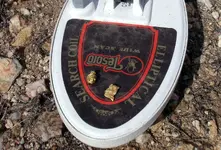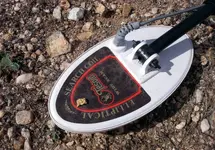You want to get a machine that has a proven track record for finding gold. Just like the sayings "Gold is where you find it" and "The best place to look for gold is where it has already been found", unless you have a ton of spare cash to experiment with, go with a detector that has a proven track record for finding the kind of gold you are looking for. Don't concern yourself with brand names and models (but of course well known names and well proven models will tend to cost more). Ask around on the forums. You will get a ton of fanboys (and fangirls) touting whatever brand they got talked into carrying, but you will also get a lot of good advice. Every manufacturer makes detectors that you can prospect with. Some are VLF and some are PI, while others are multi-freq. Which one works best for you? It all depends. Depends on what size gold you want to find. Depends on what type of ground you will be detecting on. Depends on several factors.
Small Gold,
This seems to be your issue. For smaller gold, you want a detector that runs at a higher frequency. Higher frequencies will find smaller gold, but they do so at a price. While the higher frequencies will see smaller gold, they don't penetrate very deep. That said, higher frequencies find smaller gold that is shallow. There are VLF (Goldmaster, Gold Bug, Lobo Super Traq, XTerra 705, etc), Multi-Frequency (Minelab BBS and FBS, Fisher CZ20-CZ21, White's DFX, etc), and Pulse Induction (SDC2300, SD2000, GP7000, Garrett ATX, etc).
Larger Gold,
Much of the larger nuggets close to the surface have been found. THAT is why we love rain! Every downpour takes a couple of inches off the surface, giving us more new places to hunt. Since larger nuggets tend to run deeper, you will need either a lower frequency detector or Pulse Induction. Problem is that when you are using a detector designed to find deep larger nuggets (a'la Minelab SD-2000), they don't do very well for small stuff near the surface (why mine is modded). THAT is why they were selling the GPX5000 and SDC2300 as a set (before the 7000 came out).
So, all that said, for $1000, you should be able to get MOST of what you want in a gold machine. You won't get an SDC2300 or a GTX, but that $1000 will get you a Lobo Super Traq, Gold Bug, XTerra 705 (Gold Pack), Goldmaster (all good for small gold), with a good chunk of change left over for "accessories". I don't know how long you have been detecting, but if you are hunting in Az, you will need some things:
1. Snake Garters (or snake chaps); ANYWHERE in Az that you will find gold, you will also find buzztails. The closer to Southern California you get, the more chances you will have to meet Mr. Mojave Green Rattlesnake. Rattlesnakes have Hemotoxinous Venom. That means that after being bitten, the venom goes to work destroying every red blood cell it contacts (that is why you swell and turn black at the point of envenomation). Mojave Greens (on the other hand) have both Hemotoxinous and Neurotoxinous Venom. Neurotoxinous Venom acts on your CNS (Central Nervous System). It deadens the nervous system, so that your diaphragm can't contract to bring fresh air into your lungs, so you die of asphyxiation (only after all the pain of the hemotoxinous venom has worked you over).
2. Personal GPS, with Compass and TOPO Map; A personal GPS (I have several) is important for keeping track of where you are, and also for marking waypoints of finds and such. I have also found that when you are in the detecting groove, you can lose track of where you are. A personal GPS should always have a "Backtrack" feature to get you home. I recommend also keeping a GOOD Compass and TOPO Set because when you get into temps over 120, then the crystals in your LCD Screen will not form. Then, your screen looks like a big bruise. Not much good then. If you have a compass and map, you can still get home. Oh yeah, you should really have good land navigation skills if you are going top spend time in the desert and mountains.
3. Personal GPS LOCATOR; Something like the S.P.O.T, the DeLorme In Reach, or an EPIRB. These devices will send out a satellite or radio beacon and guide emergency rescue people to you. If you take a bad spill into a ravine (example) and break both legs, as long as you have an unobstructed view of the sky, you will be rescued in a few hours.
One more thing to keep in mind is working in the heat and water. I know when you get in the detecting groove, you tend to forget about some other things (like drinking water). You have to force yourself to stay hydrated. Working in a desert environment, the human body loses about 1-2 quarts of water per hour. That means that for an eight hour day (all away from the truck), you will need to carry AT LEAST four gallons of water (2 quarts per hour lost, times hours worked, divided by 4 quarts in a gallon = (2x8=16/4=4 gallons of water). Water weighs 8.34 pounds per gallon x 4 gallons = 33.36 pounds of weight to carry (just in water). Keep that in mind when wandering far from your vehicle.
Best of luck - Mike






